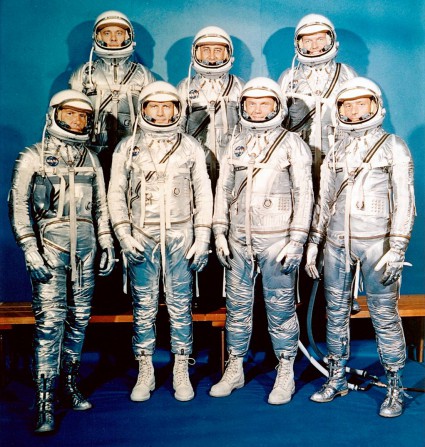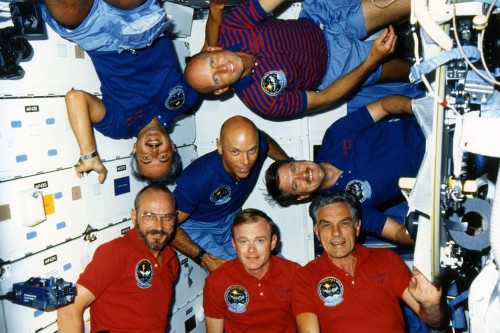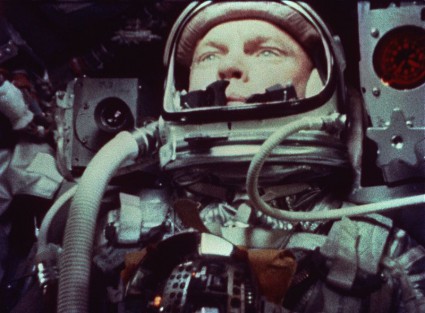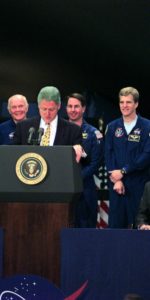
Even today, almost two decades since his headline-grabbing flight, veteran Project Mercury astronaut John Glenn retains the world record as the oldest living human ever to venture beyond the thin veil of Earth’s atmosphere and into space. He was 77 years and 103 days old at the time of his flight aboard Space Shuttle Discovery on STS-95 in October 1998. With the passing of Scott Carpenter, Glenn—now 95—is the sole surviving member of the “Original Seven” Mercury astronauts, chosen by NASA way back in April 1959. Although the arrival of commercial crew transportation capabilities offers a measure of hope that older people may someday fly into the heavens, Glenn’s accomplishment seems secure and unassailable for the foreseeable future.
When one looks back to the first two men who ventured into space—Yuri Gagarin of the Soviet Union and Al Shepard of the United States—it is hard not to be struck by the broad difference in their ages and experience; Gagarin was a 27-year-old former reconnaissance pilot, with barely a few hundred hours of flight time in his logbook, whilst Shepard was a 37-year-old engineering test pilot and instructor and a veteran of some of the world’s most cutting-edge aircraft. The astronaut and cosmonaut selection campaigns by both nations were not accidental.
The Soviets anticipated that their fliers would be embarking on lengthy careers as cosmonauts and set the age limit for their first group of candidates, selected in March 1960, at between 25-30 years old. On the other hand, NASA opted for much higher ages and levels of engineering expertise. According to Neal Thompson in Light This Candle, his 2004 biography of Shepard, the agency chose “steely, technology-savvy test pilots,” who were “mature, who’d been around, been tested and stuck it out,” rather than youngbloods for whom the fascination of space exploration might lose its luster when faced with the prospect of long hours and extremely hard work. NASA’s stipulations for its April 1959 astronaut selection campaign were that the candidates should be 25-40 years old and should hold degrees—and preferably advanced degrees at master’s level—in medicine, physical science, or engineering, together with at least 1,500 hours in their flight logbooks.

To a great extent, the respective choices of the two nations paid off. Soon after their arrival, the Mercury Seven were advised that, far from being “hired guns” on loan from their respective military services, their engineering and test piloting expertise would be actively tapped in the design and development of the Mercury spacecraft. The Soviet cosmonauts, on the other hand, had considerably less direct involvement in the engineering aspects of their spacecraft’s design and development, deferring instead to the decisions of their corps commander, Gen. Nikolai Kamanin, and to Sergei Korolev, the Chief Designer of the OKB-1 design bureau. Only later in their careers did Gagarin and several of his contemporaries enter the prestigious Zhukovsky Air Force Academy to study for their Candidate of Technical Sciences credentials.
With this in mind, it is perhaps unsurprising that the United States held the record for the oldest human space traveler, virtually from the outset. Gagarin held it for 23 days from his flight on 12 April 1961 until Shepard’s launch on 5 May, after which John Glenn flew the orbital Friendship 7 mission in February 1962, aged 40 years and seven months. He held the record until December 1965, when 42-year-old Wally Schirra commanded the ambitious Gemini VI-A rendezvous mission with Gemini VII. Three years later, in October 1968, Schirra cemented his credentials yet further, commanding Apollo 7 at the age of 45. His oldest-man-in-space lead would not last much longer, for on 26 October 1968—just four days after Apollo 7’s return to Earth—Soviet cosmonaut Georgi Beregovoi rocketed into orbit aboard Soyuz 3. Aged 47 at the time of his flight, Beregovoi had been a particularly harsh critic of the youth of several of his cosmonaut comrades.
A senior officer in the Soviet Air Force, Beregovoi was a Second World War combat veteran and decorated test pilot. In his eyes, Yuri Gagarin was “an upstart” and a bit-of-a-lad who was “too young to be a proper Hero of the Soviet Union.” The relationship between the two men grew so stormy that Gagarin is said to have shouted that Beregovoi would never fly into space. After Soyuz 3, Beregovoi entered management, eventually rising to command the cosmonaut corps, and he remained the oldest man in space until July 1975, when 51-year-old Deke Slayton served aboard the U.S. half of the joint Apollo-Soyuz Test Project (ASTP) mission. Yet Slayton’s spot on ASTP only came about through an unfortunate set of circumstances, which had caused him to be dropped from his 1962 Mercury mission and grounded for more than a decade due to a minor heart murmur. Following his flight, Slayton held onto his crown for more than seven years, until Vance Brand slightly eclipsed it in November 1982, commanding the STS-5 shuttle mission, also at the age of 51. Brand’s accomplishment was slim—he was 51 years and six months old at the time of STS-5, compared to Slayton’s 51 years and four months at the time of ASTP—but what is little known is the Soviets came close to breaking both records, two years earlier.
In November 1980, Soyuz T-3 rocketed toward the Salyut 6 space station, carrying cosmonauts Leonid Kizim, Oleg Makarov, and Gennadi Strekalov. However, this crew complement was not the one originally envisaged. More than a year before, in October 1979, veteran cosmonaut Vasili Lazarev was named as the prime crew commander. He was eventually removed on medical grounds, but had he flown Lazarev would have been 52 years old, neatly surpassing Slayton’s record. The Soyuz T-3 plot thickened, however, when another veteran cosmonaut, Konstantin Feoktistov, was also considered for a position on the crew. In June 1980—less than six months before launch—the 54-year-old Feoktistov was named to the prime crew, alongside Kizim and Makarov. It seemed a long shot, for Feoktistov’s health had been criticized in the prelude to his 1964 Voskhod 1 mission. Eventually, in October 1980, only weeks before Soyuz T-3 was due to launch, Feoktistov was dropped from the crew roster on medical grounds and replaced by Strekalov. Had either Lazarev or Feoktistov flown, it is possible that the Soviets engineered the assignment, purely for the propaganda value of seizing the oldest-man-in-space record.
As the 1980s dawned, NASA’s astronaut corps burgeoned with a new, young breed of test pilots and scientists and engineers … but there remained a few of the “Old Guard” from the earlier Apollo era, too, several of whom went on to fly the shuttle. Vance Brand did not enjoy his record for long; Bill Thornton flew aboard STS-8 in August 1983, aged 54, then broke his own record aboard STS-51B in April 1985, aged 56. Three months later, in July 1985, Karl Henize rode aboard STS-51F at the age of 58 years and nine months. Henize is an interesting case in the steady relaxation of early rules surrounding age limits of astronaut candidates. For as much as NASA desired age and experience, its uppermost limit in the early 1960s was a maximum of 40 years old, and Henize was rejected as a candidate for NASA’s first group of scientist-astronauts in 1965, partly because he was near the upper end of this age bracket. Two years later, the age limit was changed and, aged almost 41, he was selected. During initial flight instruction at Vance Air Force Base in Enid, Okla., he not only passed with flying colors, but earned the distinction of being the oldest man ever to complete the grueling 18-month military course.
Others who had been similarly affected by NASA’s age limit included Bill Thornton himself and, like Henize, he had also been rejected as a contender for the 1965 scientist-astronaut class. A year later, Thornton contacted Deke Slayton—then serving as head of Flight Crew Operations—and was encouraged to hold out for another selection cycle in 1967, in which previously disqualifying factors, including height and age, would be relaxed “in exceptional cases.” Clearly, both Henize and Thornton were considered as exceptional cases and were recognized experts in their respective fields of astronomy and aerospace medicine, and both made NASA’s exacting cut.

Karl Henize’s record endured through the traumatic years which followed the Challenger tragedy and might have endured well into the 1990s. Then, in May 1989, astronaut Jon McBride unexpectedly resigned from NASA, having already been named to command shuttle mission STS-35. To replace him, the agency selected one of its most experienced active-duty astronauts, and for the second time in his long career, Vance Brand became the oldest man in space. Launching on 2 December 1990, aged 59 years and seven months, Brand soundly exceeded Henize’s achievement. Six years later, in November 1996, Story Musgrave became the first sexagenarian spacefarer, launching aboard STS-80 at the age of 61. It was his sixth shuttle mission and, in private correspondence with this author early the following year, Musgrave had hoped to remain on active status for yet another flight, but it was not to be. He resigned from NASA in August 1997.
And there, it might be thought, the story would have ended. By the latter half of the 1990s, there were no astronauts available on active flight status who exceeded Musgrave in terms of age, and the casual observer would be forgiven for supposing that the 61-year-old record would endure for some considerable time. Then something unusual happened. Late in the summer of 1997, the rumor mill became rife with speculation that John Glenn—more than three decades since Friendship 7 and by now the Democratic Senator for Ohio—might fly aboard the shuttle as part of efforts to understand the process of aging in the strange microgravity environment. In January 1998, amid much fanfare, Glenn was formally named as a payload specialist for STS-95, scheduled for October of that same year. In flying the mission, the 77-year-old Glenn would become history’s first septuagenarian astronaut. However, some saw the flight as little more than a publicity stunt, and others argued that risking the life of Glenn, a U.S. national hero, was inexcusably rash.
In his 1999 autobiography, John Glenn: A Memoir, Glenn described the process by which he came to be considered for STS-95. “In early 1995,” he wrote, “I prepared for debate on [NASA’s] budget by reviewing the latest NASA materials, including Space Physiology and Medicine, a book written by three NASA doctors. As I read, a chart jumped out at me.” The chart described the physical effects upon astronauts in space, including muscular changes, osteoporosis, disturbed sleep patterns, balance disorders, a less responsive immune system, cardiovascular changes, loss of co-ordination, a decline in drug and nutrient absorption, and differences in blood distribution patterns.
After several years working on the Special Committee on Aging, Glenn pondered the possibility of an older person venturing into space to evaluate these effects. In his mind, such research carried potentially great implications for future International Space Station (ISS) crews, who would spend many months in orbit. Late in 1995, he approached NASA Administrator Dan Goldin for the first time with the possibility and was received with warm enthusiasm, but it would appear that Glenn’s support for President Bill Clinton in his effort to secure re-election in 1996 aided his campaign immeasurably. After discussing the idea with the president, Glenn described a flight with Clinton in Ohio, whilst on the campaign trail. “We were returning to the airport,” Glenn wrote, “when [Clinton] brought the subject up again. He grinned, leaned over and slapped me on the knee. ‘I hope that flight works out for you,’ he said.”

Of course, it was not enough to have the backing of the president. To convince the nation and the world that this was not simply an old senator and U.S. hero getting a free joy ride into space required Glenn to ensure that his mission pulled its own weight in terms of its scientific gain. And that “gain” has been repeatedly questioned over the years, with critics and supporters on both sides of the fence. “My campaign for a shuttle flight had taken me to Dr. John Eisold, the U.S. Navy admiral who was the attending physician for Congress,” wrote Glenn, “and had an office in the Capitol.” At the Bethesda Naval Hospital in Bethesda, Md., he was put through heart exams, liver, kidney, and pancreatic scans, a whole-body MRI scan, and a head scan. At the end of the grueling tests, Eisold told Glenn that he saw no physical problem which prevented the former astronaut from flying again.
At a follow-up meeting with Dan Goldin—and carrying his medical results in hand—Glenn reiterated his interest. This time, Goldin took serious notice of his words and gave Glenn two conditions: first, that his mission should be scientifically valuable, and second, that he should be able to pass all of the exams required by active-duty astronauts, many of whom were half his age. In John Glenn: A Memoir, Glenn stressed that his wife, Annie, and grown children were unhappy with the notion of him venturing into the cosmos again. (Annie’s initial response was “Over my dead body!”) However, it was turning inexorably from a dream into a reality. “Back in Washington, on 15 January 1998,” Glenn wrote, “an aide interrupted a meeting with the word that I had a phone call.” It was Dan Goldin. “You’re the most persistent man I’ve ever met,” said the NASA Administrator. “You’ve passed all your physicals, the science is good and we’ve called a news conference tomorrow to announce that John Glenn’s going back into space!”
That year, 1998, is remembered by many space enthusiasts as the time at which construction of the International Space Station (ISS) got underway, but Glenn’s flight on STS-95 in October would provide another enormous shot in the arm for America’s space ambitions. Opinion was divided, with some seeing Glenn as using his political contacts and (well-deserved) status as a U.S. national hero to curry favor with President Clinton and NASA. Others saw his flight as providing useful scientific data to understand how the human body changes and is affected by microgravity. For others, however, it was easy to see both sides of the argument … and another perspective, too.
For whatever reasons Glenn flew again, his daring and risky mission—and it was daring and risky, coming as it did betwixt the Challenger and Columbia disasters—it opened a door for older people to fly into space. Several individuals, including space tourists Dennis Tito, Greg Olsen, Charles Simonyi (on his second flight), and Expedition 36 Commander Pavel Vinogradov have since flown in their early 60s, without apparent difficulties. Their contribution to the fields of space medicine, along with that of Glenn himself, have helped to establish the necessary baseline data by which others will follow.
The second part of this article will appear tomorrow.
Want to keep up-to-date with all things space? Be sure to “Like” AmericaSpace on Facebook and follow us on Twitter: @AmericaSpace






One Comment
One Ping
Pingback:The Single Data Point: Remembering John Glenn’s Return to Space (Part 2) « AmericaSpace